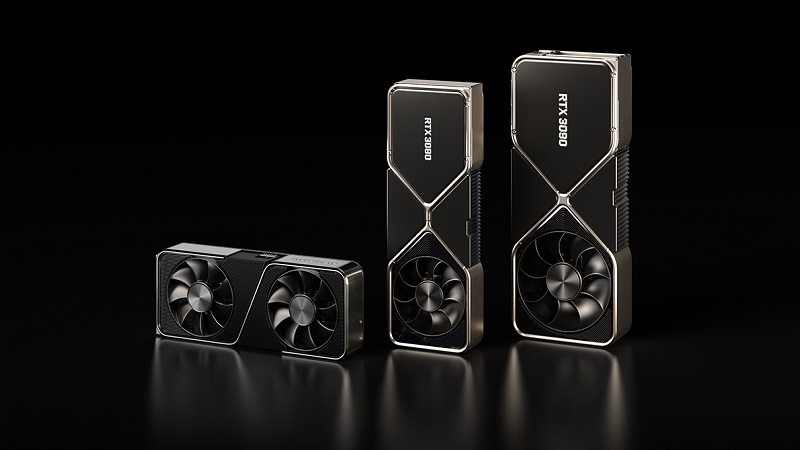Genesis Cloud Raises The Bar With New GPU Models by NVIDIA®, RTX 3080 and RTX 3090

As a user of Genesis Cloud, you can now be among the first to experience the impressive multi-GPU performance of the newest NVIDIA® models in the cloud. We proudly announce that the two new GPU types are finally available in our data center, NVIDIA®’s RTX 3080 and RTX 3090. Offering the RTX 30 series GPUs honors our commitment to being at the industry’s forefront by providing cutting-edge technology: launched in late September 2020, those models have by far the best efficiency / performance ratio for machine learning and other accelerated workloads. The key innovation about them is the impressive boost in processing power and more vRAM, which are unparalleled compared to previous generation’s models, allowing to fit larger machine learning models into the GPU memory.
The new GPUs by NVIDIA® sold out as soon as they were released last year, but we managed to get some for you and make them available on Genesis Cloud. With their impressive all-round performance they are already waiting to speed up your workloads, from VFX rendering, videos, and especially training and inference machine learning models.
Curious about how that works? Let us give you a glimpse of how the RTX 3080 and RTX 3090 achieve these impressive benchmarks and how we allow you to tap into their full potential on Genesis Cloud.
The groundbreaking technology behind RTX 3080 and RTX 3090
Acceleration and precision are the words that define the RTX 30 series. What sets both cards apart from the whole industry is a unique technology by NVIDIA®: Tensor Cores.
Tensor Cores: 3rd generation
The new NVIDIA®’s GPUs employ the third generation of Tensor Cores, which are chips built to accelerate mathematical operations from weeks to hours. Those allow GPUs to deliver accuracy for all AI workloads, as they combine mixed-precision computing with adaptive calculations. Tensor Cores boost the full range of precision, from TF32, FP64 and FP16 to INT8 and INT4. See more about Tensor Cores here.
RTX 3080
Compared to the previous GTX 1080Ti card, RTX 3080 offers new technologies such as: Tensor Cores, Mixed Precision Warp-Matrix Functions, Hardware-accelerated async-copy, Hardware-accelerated Split Arrive/Wait Barrier, and L2 Cache Residency Management. Some specifications worth highlighting are the 8704 CUDA Cores, 1.71 GHz of Boost Clock, 10GB GDDR6X of VRAM, and the 272 Tensor Cores. The card’s sparsity corresponds to 119 (or 238). See all the specs here.
RTX 3090
For its turn, the ultimate GPU by NVIDIA® combines 328 Tensor Cores, a 24GB GDDR6X VRAM, 10496 CUDA Cores, 1.70 GHz of Boost Clock, and 142 (or 285) sparsity. As the 24GB video memory runs on a 384-bit bus, this means that the card boasts 936 GB/s of memory bandwidth. An interesting feature of the model that makes it safer is its memory controller named EDR (Error Detection and Replay): when a transmission fails, instead of corrupting data, the memory keeps trying to transmit it again until it is successful. Check the full specs here.
All of those numbers stand for faster and seamless experiences.
Dr. Alexander Harpe, our Chief Business Development Officer, commented:
“The technology that underpins the RTX 30 series GPUs combine versatility and higher performance, whether it is to accelerate inference or training neural networks. We are looking forward to seeing the innovative AI applications that benefited from these features using our instances.”
Why upgrade now?
If you think your current GPU instance works just fine for your needs, consider these two points: 1) in case your business scales, soon you will need higher performance; 2) as RTX 30 Series is the latest generation and enables you to access new CUDA functionalities that are only available for newer models, like Tensor Cores, mixed precision warp-matrix functions, hardware-accelerated async-copy, hardware-accelerated split arrive/wait barrier, and L2 cache residency management.
Furthermore, NVIDIA®’s new cards sold out as soon as they were released, and the company hasn’t been able to solve the shortage problem ever since. As the company CEO Jensen Huang explained, “The 3080 and 3090 have a demand issue, not a supply issue. The demand issue is that it is much much greater than we expected – and we expected really a lot.”
Our CEO, Nicolás Chaparro, stated that:
“As a company, we are committed to supporting our clients in accelerating, innovating and creating a change in their industries, without high cost sacrifices. That’s why we chose NVIDIA®’s next-generation cards, as they bring the best cost-performance ratio in the market”
You can start accelerating right now with the RTX 30 Series. Click here to sign up.
Written on May 26th, 2021 by Genesis Cloud